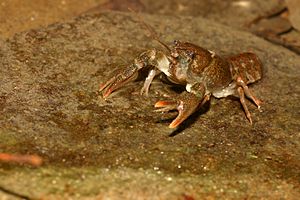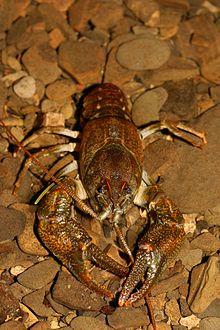Stone cancer
| Stone cancer | ||||||||||||
|---|---|---|---|---|---|---|---|---|---|---|---|---|

Austropotamobius torrentium |
||||||||||||
| Systematics | ||||||||||||
|
||||||||||||
| Scientific name | ||||||||||||
| Austropotamobius torrentium | ||||||||||||
| Cabinet , 1803 |
The stone or Bach cancer ( Austropotamobius torrentium ) is the smallest European Flusskrebsart. It typically colonizes small, summer-cold rivers with stony substrates that are free from organic pollution and municipal sewage. In addition, the stone crayfish colonizes the bank areas of lakes in higher regions. It is sensitive to organic and chemical pollution, especially insecticides .
The scientific name is derived from the individual terms gr. Potamos = river; bios = life and Latin oyster = south , torrentium, gene. Pl. Derived from torrens = river, depth.
Morphological diagnosis
Stone crabs rarely grow larger than three inches. The rostrum of the stone crabs has smooth sides and unites at the front to form an equilateral triangle. A central keel is missing. The tip of the rostrum is not detached and appears rather blunt compared to other types of cancer. The trunk is smooth, without thorns or bumps. There is also no spines behind the neck furrow. The scale of the second antenna has a sawtooth-like comb on the underside. The top of the scissors is grained and the immovable part of the scissors is studded with a hump. The underside of the scissors is light and mostly beige in color, in isolated cases light orange, but never red or dirty brown. The stone crabs are mostly brown to olive in color, but can vary from beige to light brown. Like many crayfish , the stone crabs also have a sexual dimorphism , the males are equipped with stronger claws.
habitat
The stone crab colonizes cold, small streams, larger rivers (such as the Rhine) or high-lying cool lakes. The water must reach at least 8 ° C in summer. Its optimum temperature for this time is between 14 and 18 ° C, but it can also tolerate temperatures above 23 ° C. He digs small caves under stones, roots and dead wood . The stone crab also lives in extreme mountain streams, except in those with large bed load during floods.
distribution
The species is mainly distributed in southern and southeastern Europe, in the Balkans and in the catchment area of the Danube, and occurs only in a few places beyond that, although in some cases settlement by humans cannot be ruled out. The north-western limit of distribution crosses eastern France ( Lorraine ), southern Germany approximately to the Main line, the Czech Republic and Romania. Most of the Balkan Peninsula is populated, south to Greece (at one point also in the European part of Turkey). Italy is reached in the extreme northeast (a population in the Slizza ). In Germany, Baden-Württemberg, Rhineland-Palatinate and Bavaria are settled, small occurrences exist in the extreme south of North Rhine-Westphalia, in southern Hesse, southern Thuringia and in Saxony (Dresden, only newly discovered in 2008).
Almost everywhere within this area, the species is rare and threatened. In Slovakia it only lives in a few streams in the Little Carpathians , and only four current occurrences are known from the Czech Republic.
Hazard and protection
The cancer suffers from alluvial debris, which is mostly brought in from adjacent agricultural areas. As a result, his caves are filled with sediment. It is sensitive to chemical pollution, especially insecticides . In addition, it is more sensitive to organic pollution than the noble crayfish . In addition, like all European crayfish, the stone crayfish is massively endangered by crayfish plague and invasive alien crayfish. The signal crab in particular penetrates into the stone crustaceans near the source and destroys them through direct competition or the transmission of cancer plague.
The hazardous situation is shown in the red lists . The IUCN or World Conservation Organization lists the species as endangered (Vulnerable). In Germany's national red list it appears as critically endangered (cat.2); Switzerland also rates the situation as severely endangered (cat. 2).
The stone crab is listed in Appendix III of the Bern Convention as a species in need of protection, but it can be used in exceptional cases.
The European Union adopts this variant in the Habitats Directive . It lists it in Appendix V of the strictly protected species with possible use. In addition, it places this type of cancer in Appendix II of the species for which protected areas must be established.
The Federal Republic of Germany sees the stone crayfish in the Federal Species Protection Ordinance as a particularly protected species.
In Annex 1 of the Ordinance to the Federal Law on Fisheries ("VBGF"), Switzerland places stone crabs under protection as a highly endangered species ("Category 2").
Steinbachgraben, Upper Austria
An occurrence of the stone crayfish in the Steinbachgraben, the valley of the Steinbach, which runs largely in Upper Austria (to a small extent in Salzburg ) and drains via the Mühlbergerbach to Mattig , prevents the east-side deposition of tunnel excavation material of the planned 16 from Köstendorf to Hallwang by means of an environmental impact assessment , 5 km long tunnel for the Westbahn and will lead to a delay in this construction project of the high-performance railway .
Web links
- Online identification key for crayfish in Baden-Württemberg
- Austropotamobius torrentium in the endangered Red List species the IUCN 2009. Posted by: Sket, B., 1996. Retrieved on January 4 of 2010.
Individual evidence
- ↑ Chucholl, C. & Dehus, P. (2011): Crayfish in Baden-Württemberg . Fisheries Research Center Baden-Württemberg (FFS), Langenargen, 92 pp.
- ↑ Chucholl, C. & Blank, S. & Brinker, A. (2017): The protection of the crayfish - A guide . Ministry for Rural Areas and Consumer Protection Baden-Württemberg, Stuttgart, 84 pages
- ^ DM Holdich (2002): Distribution of crayfish in Europe and some adjoining countries. Bulletin Français de la Pêche et de la Pisciculture 367: 611-657.
- ↑ Y. & L. Machino Füreder (2005) How to find a Stone Crayfish Austrapotamobius torrentium (cabinet, 1803): A biogeographic study in Europe. Bulletin Français de la Pêche et de la Pisciculture 376-377: 507-517.
- ↑ P. Dehus: Crayfish in Baden-Württemberg, endangerment and protection. Information from the Fisheries Research Center of the State of Baden-Württemberg Publisher: State Teaching and Research Institute Aulendorf, Section 7, Fisheries Research Center of the State of Baden-Württemberg.
- ↑ Profile on Art 1093 of the Habitats Directive: Stone Cancer (Austropotamobius torrentium)
- ↑ MGJ Huber & CD Schubart (2005): Distribution and reproductive biology of Austropotamobius torrentium in Bavaria and documentation of a contact zone with the alien crayfish Pacifastacus leniusculus. Bulletin Français de la Pêche et de la Pisciculture 376-377: 759-776.
- ↑ Local crayfish in NRW
- ↑ Hessen-Forst: State-wide species assessment for the stone crayfish Austropotamobius torrentium SCHRANK, 1803 ( page no longer available , search in web archives ) Info: The link was automatically marked as defective. Please check the link according to the instructions and then remove this notice.
- ↑ Species profiles Thuringia 2010: stone crab, brook crab Austropotamobius torrentium
- ^ Peer Martin, Matthias Pfeifer, Gert Füllner (2008): First record of the stone crayfish Austropotamobius torrentium (Cabinet, 1803) (Crustacea: Decapoda: Astacidae) from Saxony (Germany). Faunistic Treatises (Dresden) 26: 103-108.
- ↑ E. & M. Stloukal Haravankova (2005): Distribution of Austropotamobius torrentium (Decapoda): Astacidae in Slovakia. Bulletin Français de la Pêche et de la Pisciculture 376-377: 547-552.
- ↑ P. Kozak, Z. Duris, T. Policar (2002): The Stone Crayfish Austropotamobius torrentium Cabinet in the Czech Republic. Bulletin Français de la Pêche et de la Pisciculture 367: 707-713.
- ↑ Chucholl, C. & Dehus, P. (2011): Crayfish in Baden-Württemberg . Fisheries Research Center Baden-Württemberg (FFS), Langenargen, 92 pages
- ↑ Appendix III of the Bern Convention website from Convention on the Conservation of European Wildlife and Natural Habitats. Retrieved on January 4, 2010
- ↑ Appendix 1 of the Federal Species Protection Ordinance
- ↑ Appendix 1 Native species of fish and crabs in Switzerland. In: Ordinance on the Federal Law on Fisheries (VBGF). The federal authorities of the Swiss Confederation, accessed on January 25, 2010 .
- ↑ Traffic: stone crabs hinder high-performance railway orf.at, October 11, 2019, accessed October 11, 2019.
